U.S. Department of Transportation
Federal Highway Administration
1200 New Jersey Avenue, SE
Washington, DC 20590
202-366-4000
A traffic calming measure can cause a reduction in average vehicle speed or in the range of speeds observed (i.e., eliminate or reduce very high vehicle speeds). The speed reduction could result in a shift in traffic from the roadway (i.e., a vehicle volume reduction). The following are selected charts and tables that illustrate measured changes in vehicle speed and volume as a result of individual traffic calming measures.
The data used to derive these charts come from Traffic Calming: State of the Practice (ITE, 1999) and several recent research and data analysis documents.17
17 Developing Design Standards for Speed Cushions (Chang, K. et al, TRR 2030, 2007), Collector Street Traffic Calming: A Comprehensive Before – After Study (Buckholz, K. et al, ITE Annual Meeting, 2000), An Evaluation of Traffic Calming Measures and Their Impact on Vehicular Speeds on an Urban Principal Arterial Roadway on the Periphery of an Activity Center (Dulaski, D., ITE Annual Meeting, 2006), Traffic Calming – An Assessment of Selected On-Road Chicane Schemes (Transport Research Laboratory, TRL Report 313, 1998), Investigating the Effectiveness of Traffic Calming Strategies on Driver Behavior, Traffic Flow and Speed (Minnesota Local Road Research Board, Report 2002-02, 2001), Temporary Speed Hump Impact Evaluation (Hallmark, S. et al, Iowa State University, 2002), Kodak Park Neighborhood Traffic Management (Huffine, C., ITE Annual Meeting, 2005)
A frequency distribution of 85th percentile vehicle speeds after installation of a speed hump is presented in Figure 4.1. The plot represents data from 218 speed humps. The most frequent post-implementation speed is shown to be 27 mph, followed closely by 25 mph. These two speed values are significant deviations from an otherwise normal distribution. Based on this data, the 25-to-27 mph range would appear to be a reasonable expectation for an 85th percentile speed for a new speed hump installation (note: observed speeds at speed table installations, presented later, are on the order of 5 mph higher with the highest frequency in the 30-to-32 mph range).
The data in Figure 4.1 represent a wide range of pre-treatment speed conditions. Further investigation into the data by initial speed bins points to some differences. In general, the post-implementation speeds tend to be higher for sites with higher pre-implementation speeds.
18 The data are from measurements at speed humps. It is presumed that a speed cushion should have a similar effect on speed as a speed hump for all but large vehicles (e.g., fire vehicles) that can straddle the cushions and maintain pre-implementation speed.
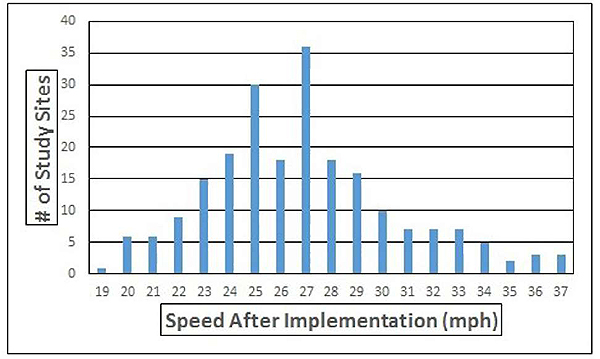
Figure 4.1. Frequency Distribution of 85th Percentile Vehicle Speeds After Implementation of a Speed Hump (All Sites)
Figure 4.2 presents a frequency distribution of post-implementation speeds for sites with pre-treatment speeds in the 36-to-40 mph range. As is the case for the entire database, the most frequent reported post-implementation speed is 27 mph, but the range of high-frequency speeds is between 25-to-30 mph with the next tier of speed reports in the 31-to-34 mph range.
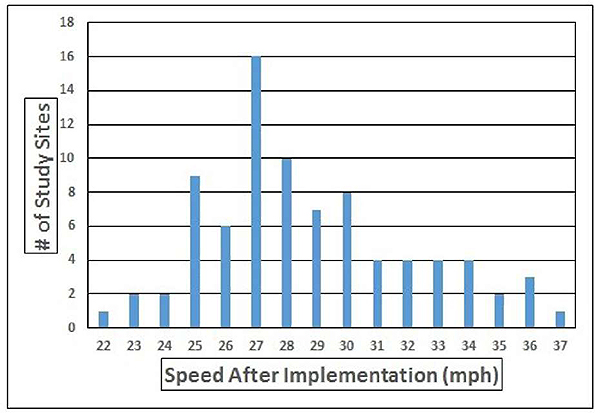
Figure 4.2. Frequency Distribution of 85th Percentile Vehicle Speeds After Implementation of a Speed Hump (with Initial Speed Range between 36 and 40 mph)
For speed humps with pre-implementation speeds in the 31-to-35 mph range, Figure 4.3 illustrates the frequency distribution for post-implementation speeds. As is the case in the preceding two charts, the most frequent speed is 27 mph; in contrast, however, the next most frequent speeds range between 23 and 25 mph.
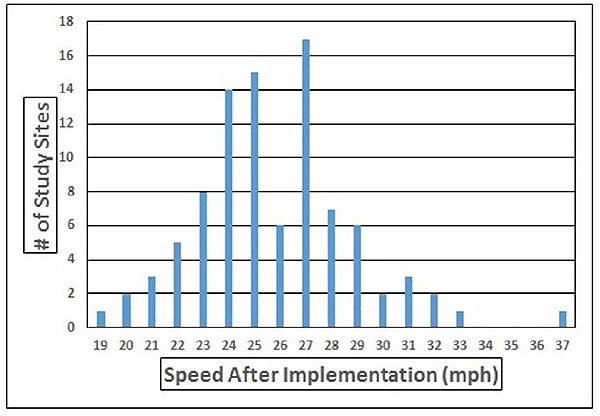
Figure 4.3. Frequency Distribution of 85th Percentile Vehicle Speeds After Implementation of a Speed Hump (with Initial Speed Range between 31 and 35 mph)
For speed humps with pre-implementation speeds in the 26-to-30 mph range, Figure 4.4 illustrates the frequency distribution for post-implementation speeds. As should be expected, the most frequent speeds are 25 and 26 mph; followed by 23 and 20 mph.
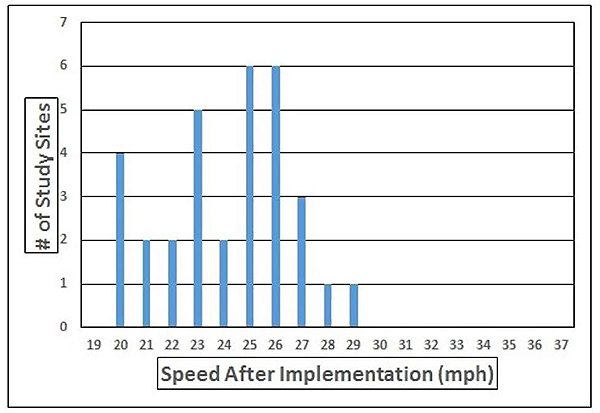
Figure 4.4. Frequency Distribution of 85th Percentile Vehicle Speeds After Implementation of a Speed Hump (with Initial Speed Range between 26 and 30 mph)
Data collected at 26 speed humps demonstrates that the effect of speed humps on high speed vehicles is dramatic. For the study sites, 14 percent of the pre-implementation traffic had a measured speed that was at least 10 mph higher than the posted speed limit. After implementation of a speed hump, this high speed traffic had dropped to an average of 1 percent of the total traffic.
Data collected at 187 speed humps demonstrate that they can have a wide-ranging effect on traffic volume. The average reduction in the reported daily volumes is 20 percent (the same average as for speed tables), with values ranging from a reduction of 72 percent on the low end to no reduction, and even an increase in some situations (where additional changes to the roadway network are presumed to have likely been implemented).
A site-specific traffic shift depends not only on the speed changes caused by the speed humps but also the availability of alternative routes that can provide a shorter travel time for a motorist that shifts routes.
A frequency distribution of 85th percentile vehicle speeds after installation of a speed table is presented in Figure 4.5. The plot represents data from 90 speed tables. The most frequent post-implementation speed is shown to be 30 mph, followed closely by values of 31 and 32 mph. Based on this data, the 30-to-32 mph range would appear to be a reasonable expectation for an 85th percentile speed for a new speed table installation [note: observed speeds at speed hump installations, presented earlier, are on the order of 5 mph lower with the highest frequency in the 25-to-27 mph range].
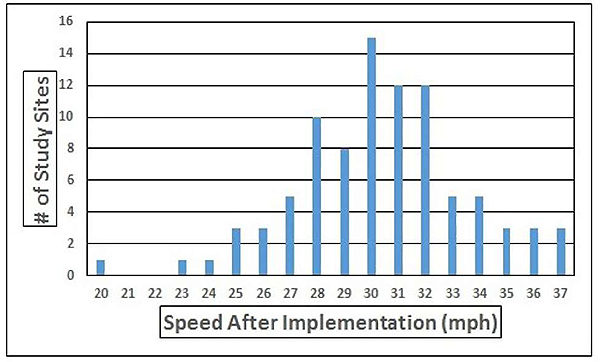
Figure 4.5. Frequency Distribution of 85th Percentile Vehicle Speeds After Implementation of a Speed Table (All Sites)
The data in Figure 4.5 represent a wide range of pre-implementation speed conditions. Further investigation into the data by initial speed bins points to similar frequency distribution of post-implementation speeds for three ranges of pre-implementation speeds: 41-to-47 mph, 36-to-40 mph (shown in Figure 4.6), and 31-to-35 mph.
19 The data are from measurements at speed tables. It is expected that a raised crosswalk should have a similar effect on motor vehicle speeds as a speed table. It is presumed that an offset speed table should, likewise, have a similar effect on speed as a speed table for all but large vehicles (e.g., fire vehicles) that can drive around the offset tables and limit any speed reduction.
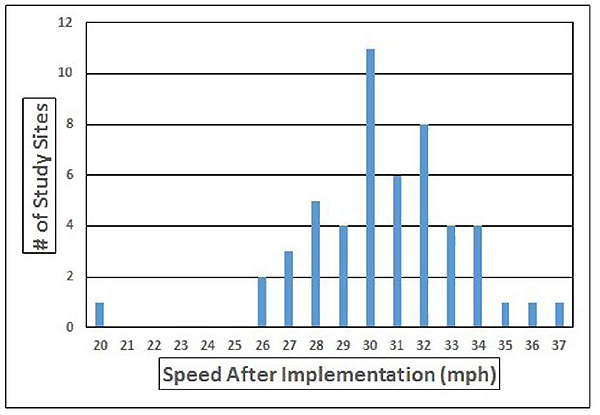
Figure 4.6. Frequency Distribution of 85th Percentile Vehicle Speeds After Implementation of a Speed Table (with Initial Speed Range between 36 and 40 mph)
Data collected at 7 speed tables demonstrates that the effect of speed tables on high speed vehicles is dramatic. For the study sites, 27 percent of the pre-implementation traffic had a measured speed that was at least 10 mph higher than the posted speed limit. After installation of a speed table, this high speed traffic had dropped to an average of 3 percent of the total traffic.
Data collected at 58 speed tables demonstrate that they can have a wide-ranging effect on traffic volume. The average reduction in the reported daily volumes is 20 percent (the same average as for speed humps), with values ranging between a reduction of 57 percent and an increase of 53 percent of the total traffic.
A site-specific traffic shift depends not only on the speed changes caused by the speed tables but also the availability of alternative routes that can provide a travel time for which a motorist could shift routes.
A summary of pre- and post-implementation 85th percentile speeds at 25 chicanes is presented in Table 4.1. For a one-lane, one-way chicane, the pre-implementation speed
Traffic Calming ePrimer
range appears to have little effect on the post-implementation speed range and average speed (26 mph). They are similar for both pre-implementation speed ranges.
For a two-lane, two-way chicane, the pre-implementation speed range appears to have a limited effect on the post-implementation speed range and average speed. The lower initial speed produces a lower post-implementation speed difference (by 2 mph), but not of the same magnitude of the pre-implementation speed differences (6-or-more mph).
| Type of Chicane | Number of Sites | Pre-Implementation Speed Range | Post-Implementation | |
|---|---|---|---|---|
| Speed Range | Average Speed | |||
| 1-lane, 1-way | 4 | 41-to-50 mph | 21-to-32 mph | 26 mph |
| 1-lane, 1-way | 8 | 29-to-37 mph | 20-to-31 mph | 26 mph |
| 2-lane, 2-way | 8 | 40-to-52 mph | 25-to-40 mph | 33 mph |
| 2-lane, 2-way | 5 | 34-to-37 mph | 27-to-34 mph | 31 mph |
A frequency distribution of 85th percentile vehicle speeds after installation of a traffic circle is presented in Figure 4.7. The plot represents data from 47 traffic circles. The most frequent speeds are shown to be 27 and 28 mph. The majority of sites with post-implementation speeds of 32 and above had pre-implementation speeds in the 36-to-42 mph range. The sites with post-implementation speeds that cluster around 27 and 28 mph had pre-implementation speeds in the 32-to-35 mph range.
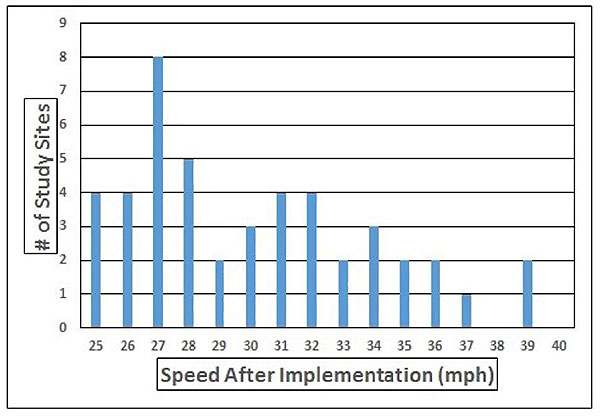
Figure 4.7. Frequency Distribution of 85th Percentile Vehicle Speeds After Installation of a Traffic Circle (All Sites)
Data collected at 51 traffic circles demonstrate that they can have a wide-ranging effect on traffic volume. The average reduction in the reported daily volumes is 29 percent, with values ranging between a reduction of 86 percent and an increase of 270 percent of the total traffic.
A site-specific traffic shift depends not only on the speed changes caused by the traffic circle but also the availability of alternative routes that can provide a shorter travel time for a motorist that shifts routes.
